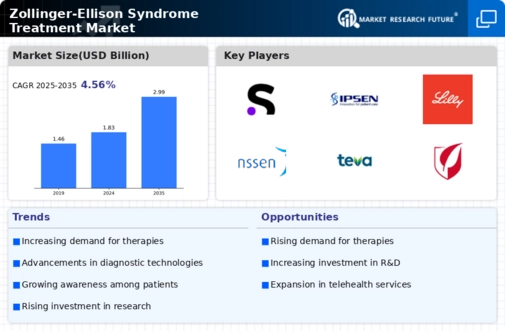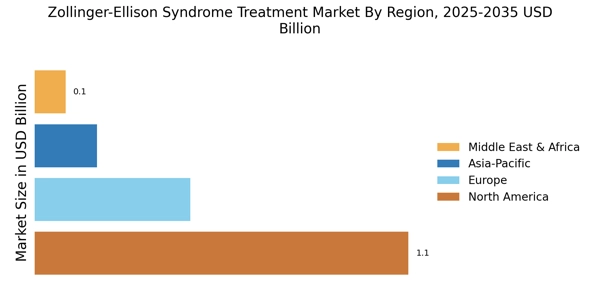Advancements in Pharmaceutical Research
Innovations in pharmaceutical research are significantly influencing the Zollinger-Ellison Syndrome Treatment Market. The development of novel drugs and therapies, particularly those targeting gastrin-secreting tumors, is enhancing treatment efficacy. Recent advancements have led to the introduction of new medications that can effectively manage symptoms and improve patient outcomes. For instance, the approval of somatostatin analogs and proton pump inhibitors has transformed the therapeutic landscape. The market is projected to witness substantial growth, with estimates indicating a compound annual growth rate of around 5-7% over the next few years. This trend underscores the importance of ongoing research and development efforts in addressing the unmet needs of patients suffering from Zollinger-Ellison Syndrome.
Emerging Technologies in Treatment Delivery
The integration of emerging technologies in treatment delivery is shaping the Zollinger-Ellison Syndrome Treatment Market. Innovations such as telemedicine, mobile health applications, and digital health platforms are enhancing patient access to care and treatment options. These technologies facilitate remote consultations and monitoring, which can be particularly beneficial for patients with rare conditions like Zollinger-Ellison Syndrome. The convenience and efficiency offered by these technological advancements are likely to improve patient adherence to treatment regimens. Furthermore, the market is witnessing a shift towards personalized medicine, where treatment plans are tailored to individual patient needs. This evolution in treatment delivery is expected to drive growth in the Zollinger-Ellison Syndrome Treatment Market, as it aligns with the increasing demand for patient-centered care.
Growing Awareness and Education Initiatives
The rise in awareness and educational initiatives regarding Zollinger-Ellison Syndrome is a significant driver for the Zollinger-Ellison Syndrome Treatment Market. Increased efforts by healthcare organizations and advocacy groups to educate both the public and healthcare professionals about this rare condition are leading to earlier diagnosis and treatment. Campaigns aimed at raising awareness about the symptoms and complications associated with Zollinger-Ellison Syndrome are crucial in promoting timely medical intervention. As awareness grows, more patients are likely to seek medical help, thereby increasing the demand for effective treatment options. This trend is expected to contribute positively to the market, as healthcare providers become more equipped to manage and treat this complex syndrome.
Rising Incidence of Zollinger-Ellison Syndrome
The increasing prevalence of Zollinger-Ellison Syndrome is a notable driver for the Zollinger-Ellison Syndrome Treatment Market. As more cases are diagnosed, the demand for effective treatment options rises correspondingly. Recent estimates suggest that the incidence rate of this rare condition is approximately 1-3 cases per million people annually. This growing patient population necessitates the development and availability of targeted therapies, thereby propelling market growth. Furthermore, the awareness surrounding this syndrome is gradually increasing among healthcare professionals, which may lead to earlier diagnosis and treatment. Consequently, the rising incidence of Zollinger-Ellison Syndrome is likely to stimulate the market for specialized treatments, including surgical interventions and pharmacological therapies.
Increased Investment in Healthcare Infrastructure
The expansion of healthcare infrastructure is a critical driver for the Zollinger-Ellison Syndrome Treatment Market. Governments and private entities are investing significantly in healthcare facilities, which enhances access to specialized treatments. Improved infrastructure facilitates the establishment of specialized centers for the diagnosis and treatment of rare diseases, including Zollinger-Ellison Syndrome. This investment is expected to lead to better patient management and outcomes, as well as increased awareness among healthcare providers. As healthcare systems evolve, the availability of advanced diagnostic tools and treatment options is likely to improve, thereby fostering growth in the market. The overall enhancement of healthcare infrastructure is anticipated to create a conducive environment for the treatment of Zollinger-Ellison Syndrome.


















Leave a Comment